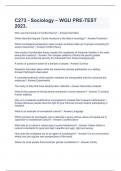Summary
Summary of Cranial nerve palsies, alphabet patterns, and surgeries
- Module
- Biomed sci Orthoptics (ORT)
- Institution
- The University Of Sheffield (TUOS)
This document covers a range of topics in second year orthoptics at university of Sheffield. It goes through the aetiology, testing, diagnosis, management and follow-up. It summarizes difficult concepts such as cranial nerve palsies. It goes through differential diagnosis of different conditions. I...
[Show more]













